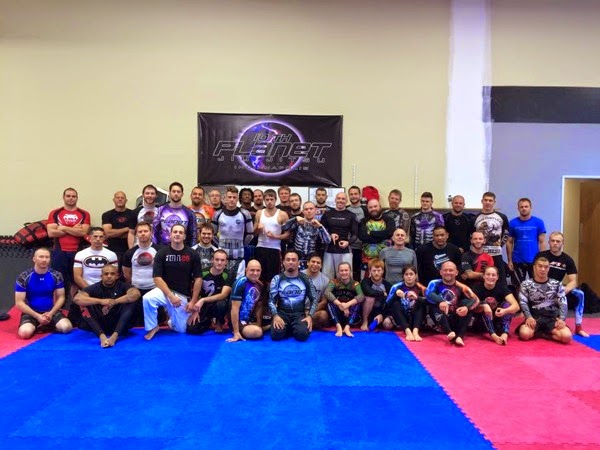On the Gaussian distribution of vicious, I’m at least in the 90th percentile of humanity. I cultivate methods of hurting other human beings. But I’m an amateur compared to the likes of muay thai former world champion, Matee “Dragonleg” Jedeedpitak, as demonstrated by his seminar at Top Level Gym. Matee has an apparently inexhaustible set of ways to control and inflict damage in the ring.
We started with a light warm-up of bouncing on the balls of our feet, then translating this into stepping out on alternating sides throwing a jab-cross. We then did one sided kicks and knees.
When you slip it is a more lateral motion and slouch than boxing to avoid getting kicked or kneed. It is important to keep looking at your opponent. Recover to your original posture, slipping back and then to the angle off the cross. To warm this up we slipped our partner’s jab, then cross, then the combo jab cross.
The jab slip counters:
- Elbow: As you slip, step deeper bringing your inside elbow up, fist pointed at the floor, and rotate the shoulder to provide power. In practice, target the flat part of your proximal forearm to their chest. In a fight, consider the axilla or chin (depending on your rules).
- Hook: Whip a hook to the chin, using the second knuckle (index finger) thumb down as of you were stabbing at a 45° degree angle into their neck. It is like throwing an inverted back hand but hit with your knuckle. We subsequently drilled this with the pads, but threw it to the belly pad for safety, followed by cross-hook-cross.
- Lead Kick: As you slip, slap/check their jabbing arm at the elbow, spinning them away from you. Now from there deliver the lead kick to the ribs, no step, simply use the spring rotation of the check. It is even more important to keep your rear heel elevated to allow the pivot.
- Hop Rear Kick: Again use the slap/check, if they step away use a small hop to deliver the kick to the leg with your rear leg. It is important to note that if they are in motion Matee recommends delivering the kick to just above the knee while if they are stationary to hit the mid-thigh.
- Side clinch: Enter as if throwing the elbow, but roll the hand up to (a) either grab the neck and push on the trapped arm or (b) clinch the hands together. Step back and knee, then pivot out to knee again.
- Body clinch: Lower your level and clinch at the waist, place your leg behind their near leg, bump it and throw them over this leg.
In order to apply this concept we drilled:
- Jab slip practice: Slip the jab laterally, straight back and medially but pretend you are sparring so that the jabs come in a broken rhythm.
- Jab-cross slip practice: As above but now slipping the jab and cross.
- Jab slip counter practice: As the first drill, but now try to apply the slip counters.
- 4-strike clinching: They throw any four alternating punches and you slip them all, return two strikes to their gloves.
Lastly we worked on some clinch counters:
- Side clinch escape: Your opponent has you side clinched. Drop your weight by bending your knees and post on their hip with your lateral hand. Lean laterally and lift your medial (formerly trapped) arm up and back (think backstroke) to escape.
- Face push clinch defense counter: You have the plum position and your opponent is pushing on your face. Look to your strong side and snap your opponent toward you (down if they are taller) as you lift the elbow on this side. Pummel your head to their triceps.
- Side clinch forearm insertion counter: Your opponent defends the slide clinch by placing a forearm in your neck, rotate your shoulder (catch their elbow between your pectorals and deltoid) and pass their frame, step behind them.
Of course Matee stressed relaxing, but also pointed out that anticipation and nervousness did not make things better. He points out not forcing your counters but having them as options depending on the rhythm of the fight.



